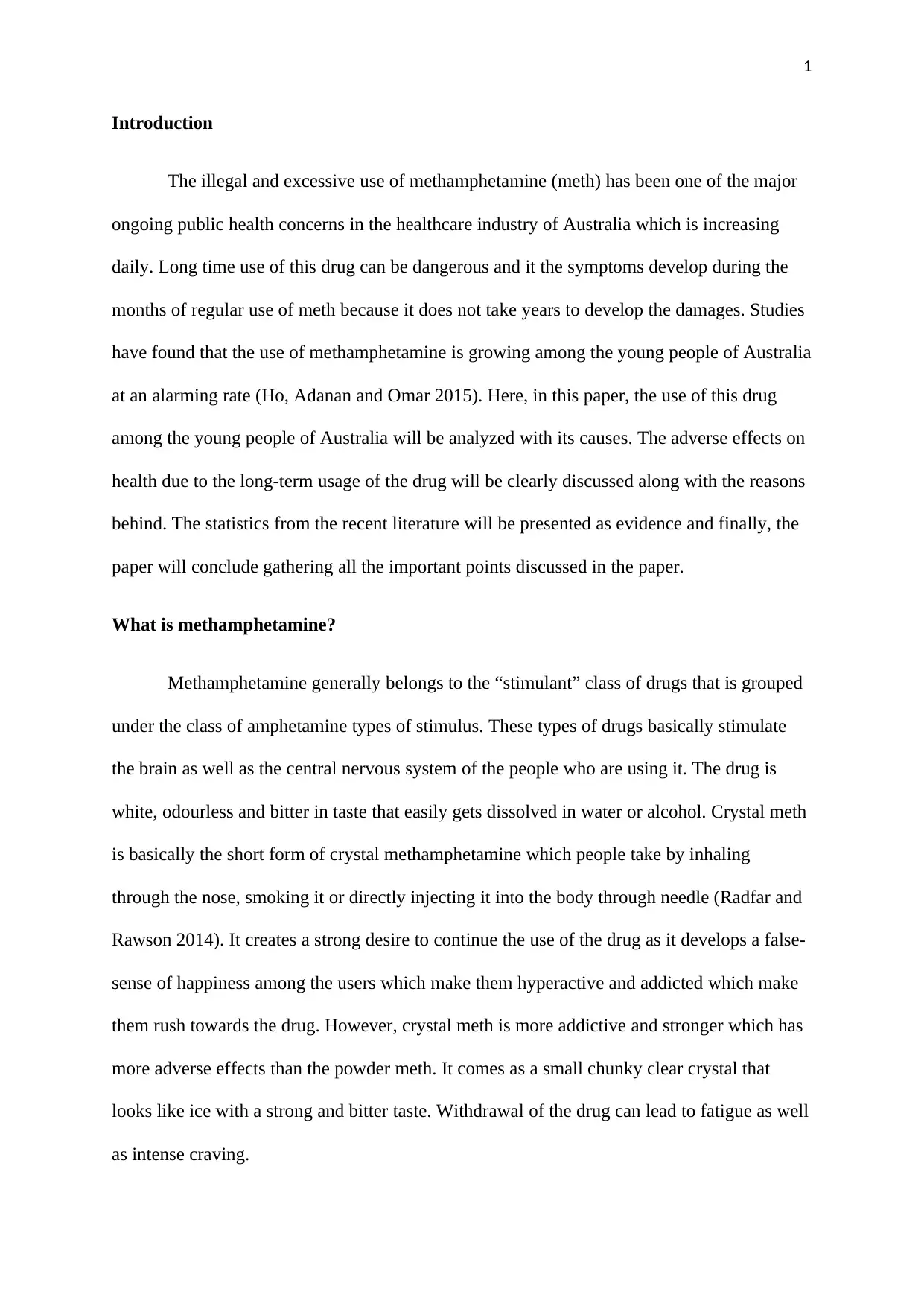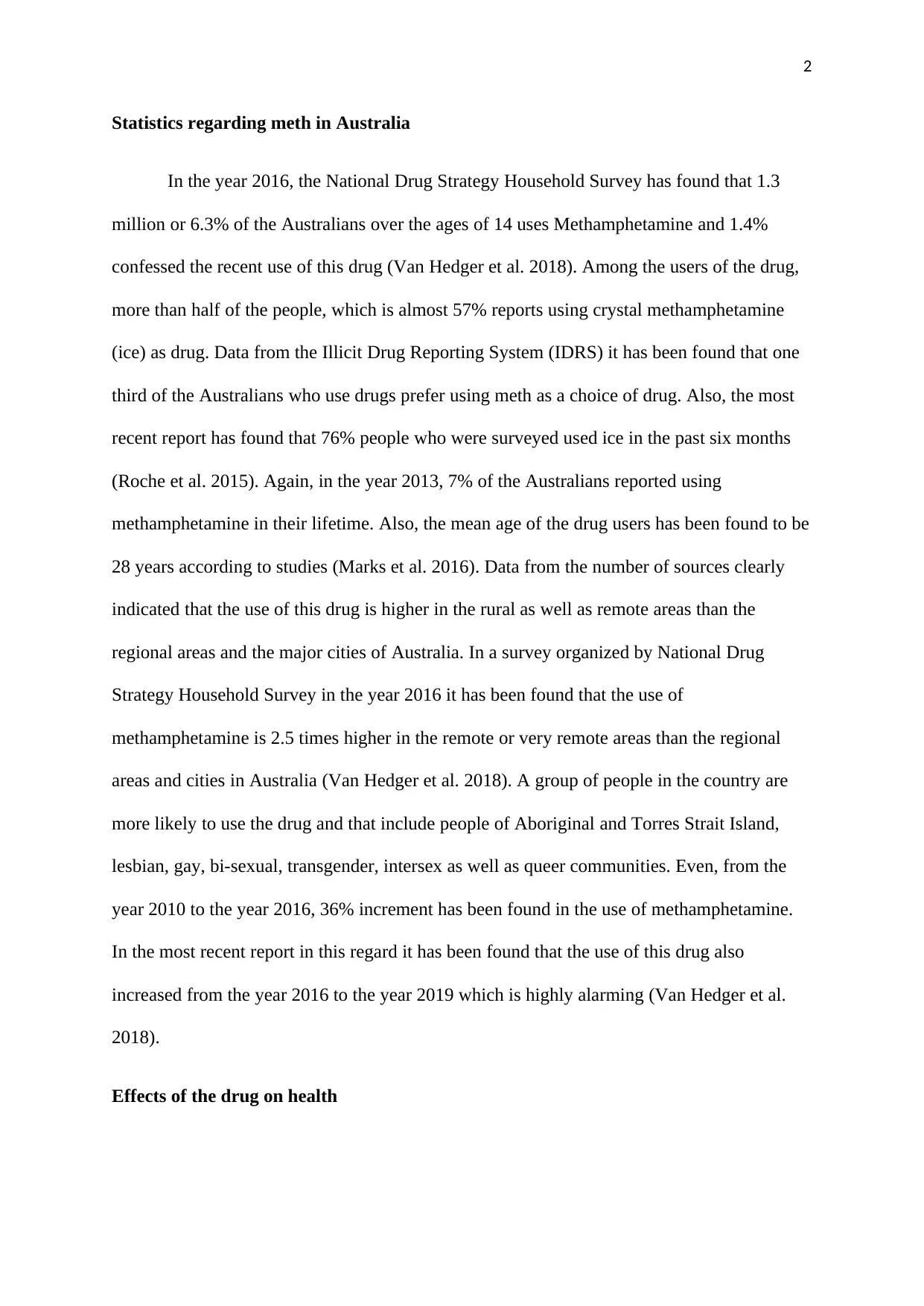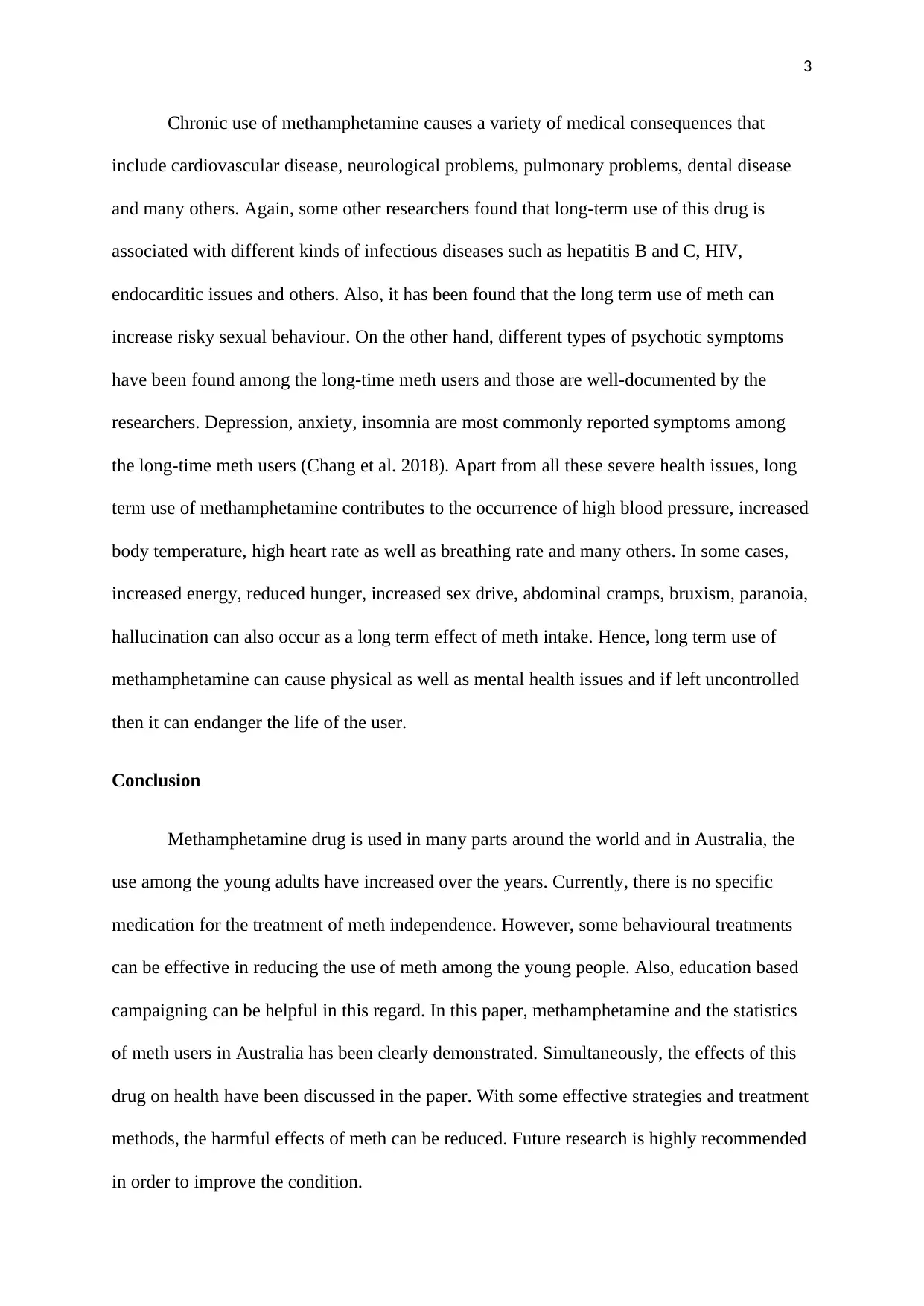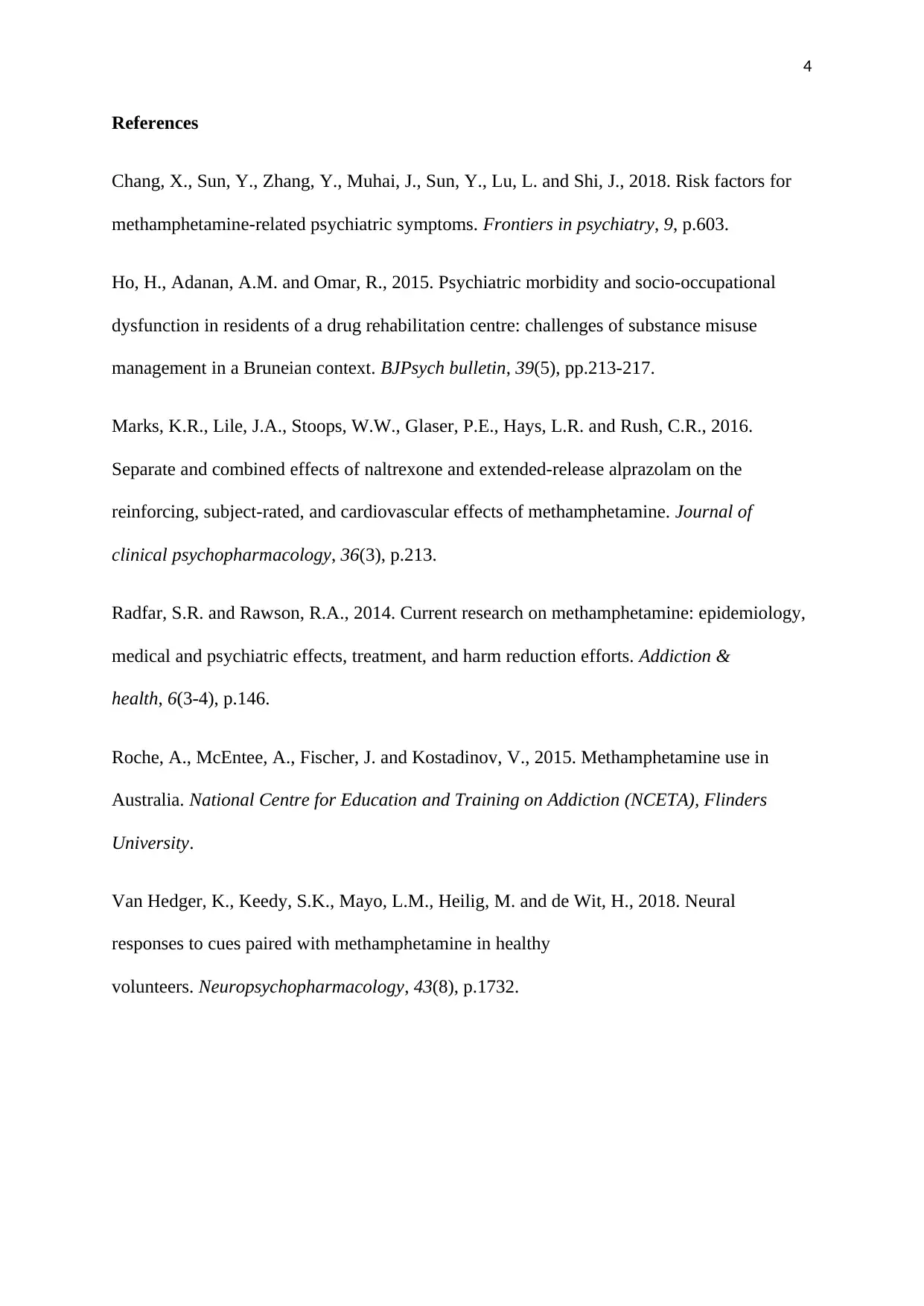Analysis of Methamphetamine Use and Health Effects in Australia
VerifiedAdded on 2022/09/09
|4
|1392
|24
Report
AI Summary
This report provides a comprehensive analysis of methamphetamine use in Australia, focusing on its prevalence, particularly among young adults, and the adverse health effects associated with long-term usage. The introduction highlights the increasing public health concern surrounding methamphetamine abuse and its detrimental impact on the healthcare industry. The report defines methamphetamine, differentiating between powder and crystal meth (ice), and presents statistical data from various sources, including the National Drug Strategy Household Survey and the Illicit Drug Reporting System, illustrating the rising trends of drug use in Australia. The adverse health effects discussed include cardiovascular and neurological problems, infectious diseases, and various psychotic symptoms such as depression and anxiety. The conclusion emphasizes the absence of specific medication for meth dependence but highlights the effectiveness of behavioral treatments and educational campaigns. The report underscores the need for future research to mitigate the harmful effects of methamphetamine and improve the condition. The report is supported by multiple references from academic journals.

1
Introduction
The illegal and excessive use of methamphetamine (meth) has been one of the major
ongoing public health concerns in the healthcare industry of Australia which is increasing
daily. Long time use of this drug can be dangerous and it the symptoms develop during the
months of regular use of meth because it does not take years to develop the damages. Studies
have found that the use of methamphetamine is growing among the young people of Australia
at an alarming rate (Ho, Adanan and Omar 2015). Here, in this paper, the use of this drug
among the young people of Australia will be analyzed with its causes. The adverse effects on
health due to the long-term usage of the drug will be clearly discussed along with the reasons
behind. The statistics from the recent literature will be presented as evidence and finally, the
paper will conclude gathering all the important points discussed in the paper.
What is methamphetamine?
Methamphetamine generally belongs to the “stimulant” class of drugs that is grouped
under the class of amphetamine types of stimulus. These types of drugs basically stimulate
the brain as well as the central nervous system of the people who are using it. The drug is
white, odourless and bitter in taste that easily gets dissolved in water or alcohol. Crystal meth
is basically the short form of crystal methamphetamine which people take by inhaling
through the nose, smoking it or directly injecting it into the body through needle (Radfar and
Rawson 2014). It creates a strong desire to continue the use of the drug as it develops a false-
sense of happiness among the users which make them hyperactive and addicted which make
them rush towards the drug. However, crystal meth is more addictive and stronger which has
more adverse effects than the powder meth. It comes as a small chunky clear crystal that
looks like ice with a strong and bitter taste. Withdrawal of the drug can lead to fatigue as well
as intense craving.
Introduction
The illegal and excessive use of methamphetamine (meth) has been one of the major
ongoing public health concerns in the healthcare industry of Australia which is increasing
daily. Long time use of this drug can be dangerous and it the symptoms develop during the
months of regular use of meth because it does not take years to develop the damages. Studies
have found that the use of methamphetamine is growing among the young people of Australia
at an alarming rate (Ho, Adanan and Omar 2015). Here, in this paper, the use of this drug
among the young people of Australia will be analyzed with its causes. The adverse effects on
health due to the long-term usage of the drug will be clearly discussed along with the reasons
behind. The statistics from the recent literature will be presented as evidence and finally, the
paper will conclude gathering all the important points discussed in the paper.
What is methamphetamine?
Methamphetamine generally belongs to the “stimulant” class of drugs that is grouped
under the class of amphetamine types of stimulus. These types of drugs basically stimulate
the brain as well as the central nervous system of the people who are using it. The drug is
white, odourless and bitter in taste that easily gets dissolved in water or alcohol. Crystal meth
is basically the short form of crystal methamphetamine which people take by inhaling
through the nose, smoking it or directly injecting it into the body through needle (Radfar and
Rawson 2014). It creates a strong desire to continue the use of the drug as it develops a false-
sense of happiness among the users which make them hyperactive and addicted which make
them rush towards the drug. However, crystal meth is more addictive and stronger which has
more adverse effects than the powder meth. It comes as a small chunky clear crystal that
looks like ice with a strong and bitter taste. Withdrawal of the drug can lead to fatigue as well
as intense craving.
Paraphrase This Document
Need a fresh take? Get an instant paraphrase of this document with our AI Paraphraser

2
Statistics regarding meth in Australia
In the year 2016, the National Drug Strategy Household Survey has found that 1.3
million or 6.3% of the Australians over the ages of 14 uses Methamphetamine and 1.4%
confessed the recent use of this drug (Van Hedger et al. 2018). Among the users of the drug,
more than half of the people, which is almost 57% reports using crystal methamphetamine
(ice) as drug. Data from the Illicit Drug Reporting System (IDRS) it has been found that one
third of the Australians who use drugs prefer using meth as a choice of drug. Also, the most
recent report has found that 76% people who were surveyed used ice in the past six months
(Roche et al. 2015). Again, in the year 2013, 7% of the Australians reported using
methamphetamine in their lifetime. Also, the mean age of the drug users has been found to be
28 years according to studies (Marks et al. 2016). Data from the number of sources clearly
indicated that the use of this drug is higher in the rural as well as remote areas than the
regional areas and the major cities of Australia. In a survey organized by National Drug
Strategy Household Survey in the year 2016 it has been found that the use of
methamphetamine is 2.5 times higher in the remote or very remote areas than the regional
areas and cities in Australia (Van Hedger et al. 2018). A group of people in the country are
more likely to use the drug and that include people of Aboriginal and Torres Strait Island,
lesbian, gay, bi-sexual, transgender, intersex as well as queer communities. Even, from the
year 2010 to the year 2016, 36% increment has been found in the use of methamphetamine.
In the most recent report in this regard it has been found that the use of this drug also
increased from the year 2016 to the year 2019 which is highly alarming (Van Hedger et al.
2018).
Effects of the drug on health
Statistics regarding meth in Australia
In the year 2016, the National Drug Strategy Household Survey has found that 1.3
million or 6.3% of the Australians over the ages of 14 uses Methamphetamine and 1.4%
confessed the recent use of this drug (Van Hedger et al. 2018). Among the users of the drug,
more than half of the people, which is almost 57% reports using crystal methamphetamine
(ice) as drug. Data from the Illicit Drug Reporting System (IDRS) it has been found that one
third of the Australians who use drugs prefer using meth as a choice of drug. Also, the most
recent report has found that 76% people who were surveyed used ice in the past six months
(Roche et al. 2015). Again, in the year 2013, 7% of the Australians reported using
methamphetamine in their lifetime. Also, the mean age of the drug users has been found to be
28 years according to studies (Marks et al. 2016). Data from the number of sources clearly
indicated that the use of this drug is higher in the rural as well as remote areas than the
regional areas and the major cities of Australia. In a survey organized by National Drug
Strategy Household Survey in the year 2016 it has been found that the use of
methamphetamine is 2.5 times higher in the remote or very remote areas than the regional
areas and cities in Australia (Van Hedger et al. 2018). A group of people in the country are
more likely to use the drug and that include people of Aboriginal and Torres Strait Island,
lesbian, gay, bi-sexual, transgender, intersex as well as queer communities. Even, from the
year 2010 to the year 2016, 36% increment has been found in the use of methamphetamine.
In the most recent report in this regard it has been found that the use of this drug also
increased from the year 2016 to the year 2019 which is highly alarming (Van Hedger et al.
2018).
Effects of the drug on health

3
Chronic use of methamphetamine causes a variety of medical consequences that
include cardiovascular disease, neurological problems, pulmonary problems, dental disease
and many others. Again, some other researchers found that long-term use of this drug is
associated with different kinds of infectious diseases such as hepatitis B and C, HIV,
endocarditic issues and others. Also, it has been found that the long term use of meth can
increase risky sexual behaviour. On the other hand, different types of psychotic symptoms
have been found among the long-time meth users and those are well-documented by the
researchers. Depression, anxiety, insomnia are most commonly reported symptoms among
the long-time meth users (Chang et al. 2018). Apart from all these severe health issues, long
term use of methamphetamine contributes to the occurrence of high blood pressure, increased
body temperature, high heart rate as well as breathing rate and many others. In some cases,
increased energy, reduced hunger, increased sex drive, abdominal cramps, bruxism, paranoia,
hallucination can also occur as a long term effect of meth intake. Hence, long term use of
methamphetamine can cause physical as well as mental health issues and if left uncontrolled
then it can endanger the life of the user.
Conclusion
Methamphetamine drug is used in many parts around the world and in Australia, the
use among the young adults have increased over the years. Currently, there is no specific
medication for the treatment of meth independence. However, some behavioural treatments
can be effective in reducing the use of meth among the young people. Also, education based
campaigning can be helpful in this regard. In this paper, methamphetamine and the statistics
of meth users in Australia has been clearly demonstrated. Simultaneously, the effects of this
drug on health have been discussed in the paper. With some effective strategies and treatment
methods, the harmful effects of meth can be reduced. Future research is highly recommended
in order to improve the condition.
Chronic use of methamphetamine causes a variety of medical consequences that
include cardiovascular disease, neurological problems, pulmonary problems, dental disease
and many others. Again, some other researchers found that long-term use of this drug is
associated with different kinds of infectious diseases such as hepatitis B and C, HIV,
endocarditic issues and others. Also, it has been found that the long term use of meth can
increase risky sexual behaviour. On the other hand, different types of psychotic symptoms
have been found among the long-time meth users and those are well-documented by the
researchers. Depression, anxiety, insomnia are most commonly reported symptoms among
the long-time meth users (Chang et al. 2018). Apart from all these severe health issues, long
term use of methamphetamine contributes to the occurrence of high blood pressure, increased
body temperature, high heart rate as well as breathing rate and many others. In some cases,
increased energy, reduced hunger, increased sex drive, abdominal cramps, bruxism, paranoia,
hallucination can also occur as a long term effect of meth intake. Hence, long term use of
methamphetamine can cause physical as well as mental health issues and if left uncontrolled
then it can endanger the life of the user.
Conclusion
Methamphetamine drug is used in many parts around the world and in Australia, the
use among the young adults have increased over the years. Currently, there is no specific
medication for the treatment of meth independence. However, some behavioural treatments
can be effective in reducing the use of meth among the young people. Also, education based
campaigning can be helpful in this regard. In this paper, methamphetamine and the statistics
of meth users in Australia has been clearly demonstrated. Simultaneously, the effects of this
drug on health have been discussed in the paper. With some effective strategies and treatment
methods, the harmful effects of meth can be reduced. Future research is highly recommended
in order to improve the condition.
⊘ This is a preview!⊘
Do you want full access?
Subscribe today to unlock all pages.

Trusted by 1+ million students worldwide

4
References
Chang, X., Sun, Y., Zhang, Y., Muhai, J., Sun, Y., Lu, L. and Shi, J., 2018. Risk factors for
methamphetamine-related psychiatric symptoms. Frontiers in psychiatry, 9, p.603.
Ho, H., Adanan, A.M. and Omar, R., 2015. Psychiatric morbidity and socio-occupational
dysfunction in residents of a drug rehabilitation centre: challenges of substance misuse
management in a Bruneian context. BJPsych bulletin, 39(5), pp.213-217.
Marks, K.R., Lile, J.A., Stoops, W.W., Glaser, P.E., Hays, L.R. and Rush, C.R., 2016.
Separate and combined effects of naltrexone and extended-release alprazolam on the
reinforcing, subject-rated, and cardiovascular effects of methamphetamine. Journal of
clinical psychopharmacology, 36(3), p.213.
Radfar, S.R. and Rawson, R.A., 2014. Current research on methamphetamine: epidemiology,
medical and psychiatric effects, treatment, and harm reduction efforts. Addiction &
health, 6(3-4), p.146.
Roche, A., McEntee, A., Fischer, J. and Kostadinov, V., 2015. Methamphetamine use in
Australia. National Centre for Education and Training on Addiction (NCETA), Flinders
University.
Van Hedger, K., Keedy, S.K., Mayo, L.M., Heilig, M. and de Wit, H., 2018. Neural
responses to cues paired with methamphetamine in healthy
volunteers. Neuropsychopharmacology, 43(8), p.1732.
References
Chang, X., Sun, Y., Zhang, Y., Muhai, J., Sun, Y., Lu, L. and Shi, J., 2018. Risk factors for
methamphetamine-related psychiatric symptoms. Frontiers in psychiatry, 9, p.603.
Ho, H., Adanan, A.M. and Omar, R., 2015. Psychiatric morbidity and socio-occupational
dysfunction in residents of a drug rehabilitation centre: challenges of substance misuse
management in a Bruneian context. BJPsych bulletin, 39(5), pp.213-217.
Marks, K.R., Lile, J.A., Stoops, W.W., Glaser, P.E., Hays, L.R. and Rush, C.R., 2016.
Separate and combined effects of naltrexone and extended-release alprazolam on the
reinforcing, subject-rated, and cardiovascular effects of methamphetamine. Journal of
clinical psychopharmacology, 36(3), p.213.
Radfar, S.R. and Rawson, R.A., 2014. Current research on methamphetamine: epidemiology,
medical and psychiatric effects, treatment, and harm reduction efforts. Addiction &
health, 6(3-4), p.146.
Roche, A., McEntee, A., Fischer, J. and Kostadinov, V., 2015. Methamphetamine use in
Australia. National Centre for Education and Training on Addiction (NCETA), Flinders
University.
Van Hedger, K., Keedy, S.K., Mayo, L.M., Heilig, M. and de Wit, H., 2018. Neural
responses to cues paired with methamphetamine in healthy
volunteers. Neuropsychopharmacology, 43(8), p.1732.
1 out of 4
Related Documents
Your All-in-One AI-Powered Toolkit for Academic Success.
+13062052269
info@desklib.com
Available 24*7 on WhatsApp / Email
![[object Object]](/_next/static/media/star-bottom.7253800d.svg)
Unlock your academic potential
Copyright © 2020–2025 A2Z Services. All Rights Reserved. Developed and managed by ZUCOL.





